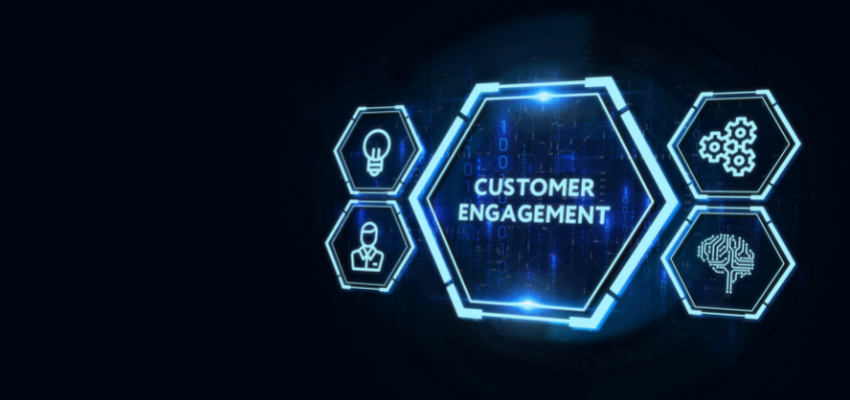Show:
The Role of Customer Engagement in Driving Sales, and Retention
Customer engagement, frequently celebrated as the fundamental element of effective marketing strategies, is a subtle yet significantly influential factor that propels sales, nurtures branding, enhances loyalty, and fortifies retention.
This in-depth article explores the core of customer engagement, its pivotal importance for businesses, and the diverse ways it drives retention.

What is Customer Engagement?
Customer engagement is about how a company builds relationships with customers, boosting brand awareness, product adoption, and loyalty. It includes various methods like campaigns, events, email marketing, and in-person interactions, aiming for genuine connections beyond transactions. Every interaction is a chance to build trust and loyalty, applicable across all business sizes.
The Importance of Customer Engagement
Effective customer engagement is vital for fostering enduring relationships with your audience. According to a study, 80% of customers equate company experiences with the value of their products and services, underscoring the significance of brand interactions in consumer decision-making.
To optimize engagement, establish clear objectives for each interaction, such as fostering loyalty, enhancing retention, improving brand sentiment, boosting revenue, and refining personalization. Analyze relevant metrics to gauge progress toward these goals. For instance, does personalized service drive higher retention rates? Do referral programs attract loyal customers who make frequent purchases?
Authentic customer engagement transcends conventional interactions by prioritizing the cultivation of enduring relationships. Engaged customers are more likely to exhibit loyalty, fostering enhanced retention rates and positive brand sentiment.
Moreover, cultivating a base of loyal consumers confers a competitive edge, particularly in times of adversity. Dedicated brand advocates are inclined to sustain their patronage, bolstering your business’s resilience and stability.
Strategies for Building Customer Engagement
To cultivate robust customer engagement, businesses can implement a myriad of strategies tailored to resonate with their target audience. Some effective tactics include:
1. Share Your Vision: Transparency breeds trust. Communicate your company’s vision and mission to show authenticity and purpose.
2. Personalize Interactions: To foster a deeper connection, and tailor experiences to individual needs, like personalized emails or product recommendations.
3. Utilize Social Media: Understand your audience and engage them on platforms they frequent. Create content that resonates and encourages participation, such as contests or polls.

4. Be an Active Listener: Value customer feedback and promptly address concerns to demonstrate genuine care and build trust.
5. Develop a Strong Brand Voice: Define your brand persona and use it consistently across campaigns to create a memorable identity, like Nike’s motivational messages.
6. Start a Loyalty Program: Reward customer loyalty with valuable incentives, like discounts or exclusive offers, as seen in Starbucks Rewards’ points-based system.
Implementing these strategies can help cultivate emotional connections and lasting relationships with your audience.
Metrics for Measuring Customer Engagement
Measuring customer engagement necessitates tracking a diverse array of metrics that reflect various facets of customer interaction and satisfaction. Some key metrics include:
1. Customer Satisfaction (CSAT)
– Measures contentment with interactions, products, or services through surveys like NPS or CSAT.
2. Social Media Metrics
– Activity on platforms: likes, shares, reach, engagement, and follower growth rate.
3. Sales and Repeat Purchases
– Indicates brand resonance and loyalty. More repeat purchases imply stronger engagement.
4. Feedback and Reviews
– Reflects opinions about the brand, including negative feedback which shows engagement with brand improvement.
5. Subscriber Count
– Signifies broad reach and long-term commitment. High subscribers show potential for engagement, but quality matters.
6. Customer Effort Score (CES)
– Measures the ease of customer experience, assessing the effort required for support or issue resolution.
7. Customer Loyalty
– Loyal customers make repeat purchases and referrals, indicative of strong engagement and emotional connection.
Driving Retention through Customer Engagement
Customer engagement serves as a linchpin for driving retention, underpinning long-term relationships and sustained brand loyalty. Engaged customers are more likely to perceive the brand’s value proposition positively, leading to a prolonged lifecycle and enhanced customer success rates. Businesses can fortify retention efforts by prioritizing customer engagement initiatives and cultivating enduring customer relationships.

Tips To Handle Different Types of Customers
Different customers have varying needs, requiring tailored approaches for satisfaction. Here’s a breakdown:
1. New Customers: Require smooth onboarding, assistance, and a seamless journey. Offer social proof through reviews and ratings.
2. Potential Customers: Need specific solutions and nurturing. Provide excellent user experience, value demonstration, and easy access to support.
3. Angry Customers: Seek empathy, solutions, and quick resolution. Monitor channels, understand issues, and train staff for effectively handling angry customers.
4. Curious Customers: Crave information and support. Ensure self-service options, informative content, and knowledgeable live chat.
5. Loyal Customers: Desire appreciation and personalized experiences. Spotlight them, form alliances, and offer loyalty rewards.
6. Impulse Customers: Want a seamless experience and assistance. Showcase offers, simplify checkout, and suggest relevant products.
7. Discount Customers: Seek the best deals and exceptional service. Explain value, assist with discounts, and offer added value beyond deals.
8. Active Customers: Require attention and nurturing. Provide additional value, engagement, and focus on their success.
9. Lapsed Customers: Need solutions and a personalized approach. Identify reasons for leaving, fix issues, and offer enticing incentives for return.
10. Confused Customers: Seek fast solutions and clear explanations. Ensure availability of contact channels and prioritize customer service.
11. Need-based Customers: Look for efficient service and user experience. Fulfill their needs promptly and consider subscription models for convenience.
12. Referring Customers: Require motivation and community involvement. Maintain product quality, foster a sense of belonging, and offer incentives for referrals.
Wrapping Up
Prioritizing genuine connections, personalized interactions, and transparent communication fosters enduring relationships with customers, driving sales and enhancing retention in today’s competitive business environment. These relationships boost sales and brand loyalty and provide resilience against market challenges, ensuring sustained success. As businesses evolve, mastering customer engagement nuances remains crucial for long-term growth and prosperity.

 Return to Previous Page
Return to Previous Page








